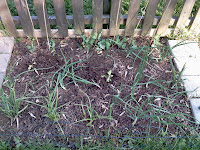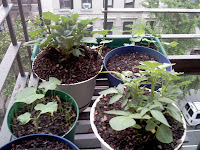
On Saturday, I got my mom flowers and took both of my parents to a fancy restaurant. I have a deep bond with my folks, and I often miss them terribly when in the city. Life can be quite hard sometimes, and the difficulties only makes me appreciate the love that my parents have shown me time and time again. And with so few chances to see them, one must seize every opportunity to do so. In any case, on Saturday afternoon, I got a chance to work in my garden. Much has transpired since the last time I was around here. The apple trees are in full bloom. The Red Delicious tree had beautiful white blossoms, while the Wine Sap tree was adorned with delicate pink flowers. These two trees are destined to be partners with each other in the coming years. The 2 blackberry brambles have met with a sad fate. One of the bushes had been pulled out by hooligans awhile back. The remaining bush, being planted closer to the rain water drainage pipe had suffered an unacceptable degree of root damage due to flooding. It's a regretable loss, but one learns more from failure than success in the garden.

The asparagus plants are growing fairly well, though with an acceptable degree of loss. Of the 7 crowns planted, 5 have survived and are growing woody green shoots skywards. After they get a little taller and put in some more leaves, I'll be filling in the trenches to encourage more root development. One of the crowns didn't survive the transplant, the dead crown was being devoured by worms. I removed the dead crown from that trench, and filled it with garden soil mixed with compost. In this cleared trench, I planted some corn and pole beans. Another crown appeared to still be alive, but isn't growing any shoots. This could be due to the trench being surrounded by vigorous sun-hogging clover or it could be due to the inferior genetics of the crown itself. In any case, I'll check on the crown the next time I'm home. If it still hasn't developed properly, it'll have to be culled.

The 4 container potatoes are doing extremely well. Container grown potatoes usually grow faster and yield a bit more than those grown in a garden bed for me. The Rotten and Yukon Gold varieties have expanded like crazy over the last two weeks, shooting a foot and a half higher than the last time I saw them. Thus, I had to fill more garden soil and compost around the grown plants, until the soil had reached the rim of each container. I'm seeing little sign of pest damage so far, which is pretty awesome!

Garden bed 1 is doing fairly well. The snow peas have largely developed, and are now climbing up the bamboo poles that I have set down there earlier. But it was pretty apparent to me that a significant portion of snow pea seeds have not germinated. This could be due to predation from birds or inferior seed stock. In anycase, I planted some pole beans(European and Kentucky varieties) to succeed the peas. The snow pea plants will end their life cycle sometime in august from the heat, and right then the next wave of pole bean plants would be just about ready to yield. Thus ensuring a continous stream of lingumes.

In garden bed 2, the situation was significantly better. Most of the sugar snap peas have germinated and are growing vigorously. So vigorously in fact, that I had trouble finding sites to plant my pole beans. For some reason the sugar snap peas grow and flower much faster than snow peas, yet the two varities can(and will) interbreed with each other at some point. After sowing some succession beans, I set down a roll of sweet corn along the edge of the bed. The sweet corn will develop in time to catch some of the pole beans, thus providing a living scaffold.

Garden bed 3 had a plethora of crops growing. There were 3 varieties of peppers(Afghan Red, Acapulco, Jalapeno ), 1 european eggplant(Plantagenet), 3 native-amerian squash varieties(acorn, butternut, summer). The peppers are growing furiously, taking advantage of the full sunlight. The lone eggplant is looking pretty sad with tiny bite marks on the leaves. I assume that it's due to aphids or some kind of mites. The eggplants have always performed poorly in my garden. I sometimes wonder if the Eurasian vegetable is hardy enough to survive here.

Garden bed 4 was the land of the onions. It's populated by Begian red onions and French yellow onions, their tubuler green stalks waving in the air. The 3 California garlic plants are doing just as well, with their flat stalks forming small bushes. There were several Wally Pea plants along my neighbor's fence. The wally peas are quite different from the snow and sugar snap peas, it's leaves are smaller and squat looking. The entire plant seems to be covered with very small and light hairs for some reason. Surveying the site, I found 3 spots for my Bok Choi seedlings. I had started 10 seedlings indoors a month back. The Bok Choi, being an East Asian lettuce variety, may not be adequately adapted to this climate. Of the 10 seeds started, 7 germinated indoors, and only 3 survived the seedling transition to the outdoor weather of early May. I'm not sure how many of the 3 will live through the shock of transplanting. I would be happy if just one of the Bok Choi seedlings made it to bolting stage. In anycase, I planted in some pole beans along my neighbor Peter's fence for good measure. The entire garden bed smells a bit like a kitchen to me. After the new plantings, I cut away some of the onion chives(1 lb) for my mom's kitchen. Both onions and garlic are cut and come again crops which will provide many more cuttings before the end of the season. The bulbs that are finally harvested are merely icing on the cake so to speak! Besides being tasty, onions and garlic are also packed with natural anti-biotics which keeps us humans safe from certain bacteria and parasites.

Garden bed 5 has 4 tomatoes(brandywine, beefsteak, early girl, cherry) and 1 cucumber plant growing in it. The plants in this bed are very heavy feeders of both nutrients and water. I planned this bed as a sort of experiment into the bio-intensive method of gardening. This approach will yield significantly more food than before, but will also require more effort in terms of maintenance. In anycase, the growing tomatoes are planted so closely together that they'll need to be trained to fill in a 3-dimensional cube of space directly above the bed. For this purpose, I shelled out some hard currency to purchase 2 sets of foldable trellises. These 2 trellises, were set down in a zig zag pattern, neatly supporting and partioning each of the 4 tomatoes. Basically, each tomato will be trained to occupy a separate cubic space created by the trellis, while the cucumber will be trained to fill a rectangular wedge of cubic space directly beneath the tomato canopy. This will create a single 3 dimensional block of densely intertwined plant vegetation, roughly 4x4x5 cubic feet in volume. Now so much vegetation will require a great deal of water. So I implemented a kind of green mulch, I cut the tall grass on the edge of my garden and layered them uniformly around each of the plants. The mulch serves the triple functions of supressing weeds, retaining water, and releasing nutrients into the soil, thus reducing some of the human effort required to maintain this structure.

Garden bed 6 has 6 potato plants. They are all doing well, though not as well as their container counterparts. I created small hills of soil around each developing plant and checked everyone of them for signs of disease and pests. Everything checked out fine so far. I then planted pole beans around the edge of the bed and along the fence. The potato/bean/turnip triad is a tried and true pattern for my garden.
Good times with my family and fun in the garden made it a great mother's day weekend. Though I must say, if that special person was there with me, it would've been perfection itself! :D
 Ever since I shelled out 50 dollars of hard currency for my used mountain bicycle, I had wanted to use the vehicle to circumscribe the isle of Manhattan. The bicycle is an incredibly energy efficient transportation device. For every mile traversed, the rider uses only about 25 calories of food energy. Riding the bicycle is literally a hundred times as fuel efficient as driving a car, mile for mile. In light of recent spikes in Gasoline prices, I believe that we need to entertain the possibility of a long term reduction in gas and diesel fuel supply. Thus cities should really make an attempt to drive it's citizens towards incorporating petroleum independent transport technologies such as bicycles.
Ever since I shelled out 50 dollars of hard currency for my used mountain bicycle, I had wanted to use the vehicle to circumscribe the isle of Manhattan. The bicycle is an incredibly energy efficient transportation device. For every mile traversed, the rider uses only about 25 calories of food energy. Riding the bicycle is literally a hundred times as fuel efficient as driving a car, mile for mile. In light of recent spikes in Gasoline prices, I believe that we need to entertain the possibility of a long term reduction in gas and diesel fuel supply. Thus cities should really make an attempt to drive it's citizens towards incorporating petroleum independent transport technologies such as bicycles. 











